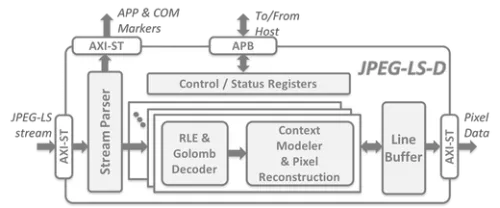The JPEG-LS-D core implements a highly efficient and low-power, lossless and near-lossless image decompression engine that is compliant to the JPEG-LS, ISO/IEC 14495-1 standard.
The decoder core can decompress any JPEG-LS stream or JPEG-LS payload of image container formats, such as DICOM (Digital Imaging and Communications in Medicine). It accepts compressed streams of images with up to 16-bit per color samples and up to four color components, in all widely used color subsampling formats. Supporting oversize image dimension parameters, the core can decode image with resolutions exceeding 64k x 64k pixels.
The easy-to-use JPEG-LS-D core operates on a standalone basis, parsing marker segments and decompressing coded data with no assistance from a host processor. The decoder reports the image format (i.e., resolution, subsampling format, and color sample-depth) to the system, so that the decoded images are properly further processed and/or displayed. Application (APP) or comment (COM) marker segments—which are typically used to embed metadata in the compressed stream—are also passed to the system via a dedicated interface.
SoC integration is straightforward thanks to standardized AMBA® interfaces. The core accepts compressed data and outputs pixel data, frame format information, and APP or COM marker segments via AXI4-Stream interfaces, and it provides access to its control and status registers via a 32-bit APB interface. A wrapper that bridges the AXI-Stream interfaces to AXI4 can optionally be delivered with the core.
The core is designed with industry best practices, and its reliability has been proven through both rigorous verification and silicon validation. The deliverables include a complete verification environment and a bit-accurate software model.
This core can be mapped to any Intel, Lattice, MicroSemi, or Xilinx programmable device, or to any ASIC technology, provided sufficient silicon resources are available. Please contact CAST Sales to get accurate characterization data for your specific implementation requirements.
Lossless & Near-Lossless JPEG-LS Decoder
Overview
Key Features
- JPEG-LS ISO/IEC 14495-1 Standard Support
- All JPEG-LS encoding parameters
- Optional Near Lossless support
- All interleaved modes
- All marker segments including APP, COM, DNL and Restart markers
- Image resolution higher than 64Kx64K (supports oversize image dimension parameters)
- Up to 16 bits per color sample, and up to four color components
- Easy to Use and Integrate
- Requires no programming or control from host
- Reports image format
- Detects and reports marker syntax errors
- Delivered with bit-accurate software model
- AXI4-Stream Interfaces for image and compressed data, and 32-bit wide APB for register access
- Dedicated interface for APP and COM markers to pass metadata to system
- Versions and Throughput
- One sample per cycle, for the area optimized JPEG-LS-DS version
- From 40,000 eq. gates and up to 350 Msamples/sec on a typical 16nm technology
- Synthesis-configurable number of samples per cycle, for the throughput optimized JPEG-LS-DF version. Maximum throughput is only possible when images are encoded using restart markers.
Block Diagram

Applications
- The JPEG-LS-D is suitable for applications requiring numerically or visually lossless compression of images or video of potentially high color or greyscale accuracy such as medical Imaging (DICOM), aerospace imaging/surveillance, and advanced driver assistance systems (ADAS).
Deliverables
- The core is available in source code RTL (Verilog) or as an FPGA netlist, and its deliverables include everything required for successful implementation:
- Sophisticated self-checking Testbench
- Software (C++) Bit-Accurate Model
- Sample simulation and synthesis scripts
- Comprehensive user documentation
Technical Specifications
Maturity
Production Proven
Availability
Now